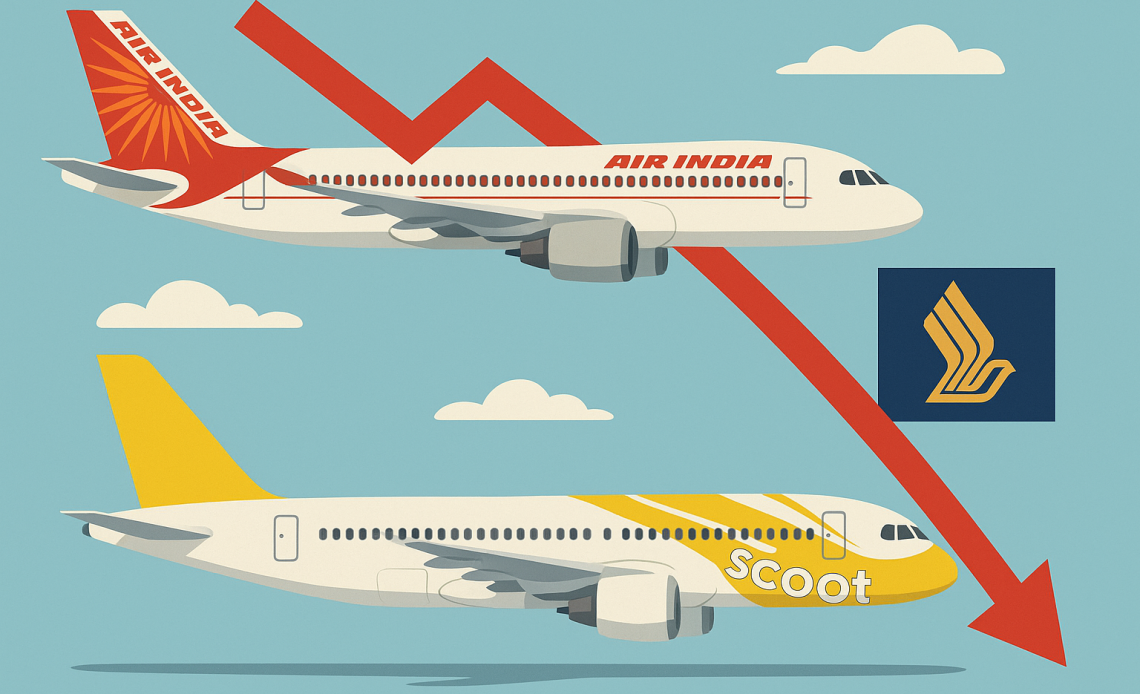Singapore Airlines saw its sharpest quarterly net income decline in more than three years as financial losses from its equity in Air India weighed heavily on results.
For the three months ending 30 September, the group reported a net income of S$52 million, marking an 82% drop from the previous year.
The airline’s revenue edged up by 2.2% to S$4.9 billion, while operating profit increased by 23% to S$398 million.
Despite the rise in revenue and operating efficiency, the group’s performance was dampened by a significant fall in contributions from its associated companies.
A S$417 million year-on-year decline in associated company income during the first half of the financial year was directly tied to Singapore Airlines’ 25.1% stake in Air India.
The Indian carrier has struggled with compounding operational and financial challenges, including the aftermath of a fatal crash earlier this year.
In response, Air India is seeking at least ₹100 billion ($1.1 billion) in funding from its joint owners, Tata Sons and Singapore Airlines.
Yield pressures reflect market competition
Singapore Airlines has had to manage profitability across a turbulent international landscape. Passenger yields declined by 3% during the quarter, falling to 9.8 Singapore cents per kilometre.
This metric, which measures revenue per passenger kilometre, is closely watched by investors for indications of pricing power.
Although the downward trend in yields is softening, the airline remains under pressure to maintain margins.
Operating costs stayed broadly level, and lower fuel expenses provided some relief, but not enough to counter the financial impact from external investments.
In the context of global economic headwinds, supply chain uncertainties, and geopolitical risks, the carrier’s profitability remains vulnerable to fluctuations in foreign investments and regional airline dynamics.
Scoot capitalises on low-cost vacuum
While international ventures placed downward pressure on the group’s net profit, its budget unit Scoot demonstrated strong resilience.
The low-cost subsidiary recorded load factors above 90% for six straight months through September.
This performance came as Jetstar Asia exited the market in July, reducing competition and creating fresh capacity for Singapore Airlines to expand.
Together, Scoot and the flagship SIA brand carried a record 10.5 million passengers during the quarter.
The group responded to the increased demand by ramping up flight capacity, helping fill the gap left by the departing competitor.
Scoot, in particular, has benefited from an agile fleet and route network strategy that allowed it to quickly absorb displaced passengers from Jetstar Asia.
The current environment has presented opportunities for consolidation in the low-cost carrier segment across Southeast Asia, a space where Scoot is now more firmly positioned.
Strategic risks and operational momentum
Despite challenges, Singapore Airlines expressed confidence in its near-term outlook. Demand for air travel continues to be steady, even as macroeconomic conditions remain uncertain.
The group remains focused on strengthening its position across both premium and budget travel segments.
Its financial exposure to Air India, however, adds an additional layer of strategic risk.
The ongoing need to support the Indian airline’s turnaround adds pressure to group-level results, particularly at a time when international capital deployment is more closely scrutinised.
Nonetheless, with disciplined cost control, record passenger volumes, and strong performance from Scoot, the group retains flexibility in how it navigates the next phase of post-pandemic recovery.
The post Air India woes trigger 82% net income slide for Singapore Airlines appeared first on Invezz







